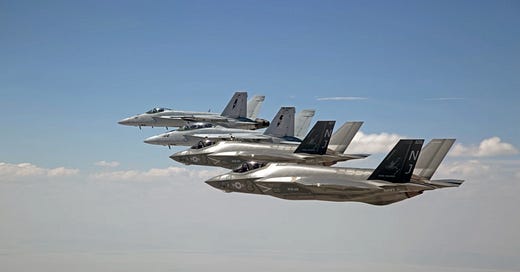TACAIR's Anti-Surface Pocket Rockets
...falling in love with the mission kill all over again...
Yes, the US Navy is no longer the world’s largest navy.
Yes, the People’s Republic of China has +200 times the shipbuilding capability the USA has.
OK, if we accept the above - what can we do about it?
Find a way to make the odds better.
We need to find a way to give our aircraft anti-surface weapons they can launch from distance, in enough numbers to overwhelm air defenses, and then hit something…anything.
Numbers and range. You know, the same fundamentals of naval warfare since the invention of better bows.
What about size? For those old enough to remember the old Soviet monsters designed to take out aircraft carriers, our Harpoons and similar sized ASCM seem quite small. When carried on tactical aircraft, all modern ASCM don’t seem small though - they are kind of large.
Large missiles are expensive. They impart a lot of drag to aircraft, decreasing range.
Do they need to be that bulky to get the job done?
If we have learned anything from the age of the anti-ship cruise missile over the last half-century of combat use, it is that they don’t need a big warhead…heck, or any warhead, to get at least a mission kill on a ship, and you might even sink it or take it out of the fight for months or years just by the fires its unused fuel start.
As the USS Saratoga showed us the year after Desert Storm - a sparrow air to air missile is enough to take out a warship. (Fun note: the TACAIR bubbas really wanted to investigate this ability. I remember some F-14 guys serious as a heart attack about it. That might be part of the pedigree to the below.)
If you buy big with a fixed budget, you don’t buy many. If you don’t buy many, you don’t have much density. Without density, you don’t have many numbers forward deployed. With that, you only have a few to launch. If your enemy is halfway competent, then they have an easier job defeating any attack.
How do you get around that? Buy a lot of smaller, cheaper, easier to mass, harder to kill missiles.
Smart. Just plain smart, and it looks like that is right where we’re going.
Via Joseph Trevithick over at The Drive;
Naval Air Systems Command put out a contracting notice for what it is currently calling the Multi-Mission Affordable Capacity Effector weapon system, or MACE, on February 2. This followed the Direct Attack Contracting Division of the Air Force life Cycle Management Center's Armament Directorate (AFLCMC/EBDK) issuing a separate notice about what it has dubbed the Extended Range Attack Munition (ERAM) on January 30.
As the Navy's MACE contracting notice makes clear, fielding smaller, but still capable stand-off munitions can have significant operational benefits. Helping F-35s carry more munitions internally gives them more firepower while operating in the most stealthy mode. Non-stealthy tactical jets, like the F/A-18E/F, can also carry these weapons and likely in significant numbers given their size and weight. All of this translates to more striking power for individual aircraft per sortie.
…
The requirements NAVAIR has laid out publicly for MACE include an equivalent range to the AGM-158C-1.1 Long Range Anti-Ship Missile (LRASM) when released from an aircraft flying at a speed of Mach 0.8 at an altitude of 30,000 feet above sea level. The AGM-158C-1.1's maximum range is classified, but publicly available information says that it is similar, if not identical to that of the AGM-158A Joint Air-to-Surface Standoff Missile (JASSM) land-attack cruise missile, which publicly available information says is between 200 and 300 miles.
…
Against warships, something like MACE could be less survivable, on an individual basis, as well as less capable of causing significant damage. At the same time, the higher volume of missiles would help overwhelm shipboard defenses, which is a significant concern facing modern navies as The War Zone recently explored in detail the context of the Navy's future Constellation class frigates. A single smaller missile could still very capable when employed against a smaller warship and the combined damage from many of them scoring hits on larger vessels could be substantial. Even one hit could cause a mission kill, putting critical weapons and sensors out of action, making the ship vulnerable to follow-on attacks in the near term, and put out of action for a prolonged period of time in the longer term.
If you can’t outbuild them, then outkill them.





Can you spell "Sherman versus Tiger?" I knew you could.
Wow. Lots of missiles to overwhelm ship air defenses. It’s almost like someone rediscovered the Watkins-Gabriel Memorandum of Agreement from 1982 that led to the effort of modifying B-52G’s to carry buttloads of AGM-84s.